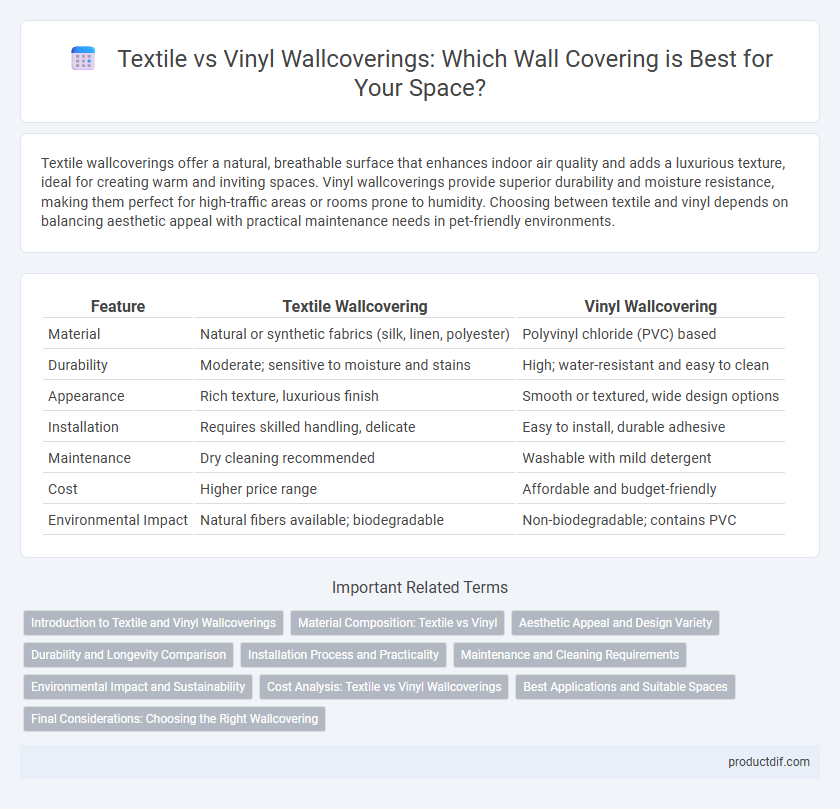Textile wallcoverings offer a natural, breathable surface that enhances indoor air quality and adds a luxurious texture, ideal for creating warm and inviting spaces. Vinyl wallcoverings provide superior durability and moisture resistance, making them perfect for high-traffic areas or rooms prone to humidity. Choosing between textile and vinyl depends on balancing aesthetic appeal with practical maintenance needs in pet-friendly environments.
Table of Comparison
| Feature | Textile Wallcovering | Vinyl Wallcovering |
|---|---|---|
| Material | Natural or synthetic fabrics (silk, linen, polyester) | Polyvinyl chloride (PVC) based |
| Durability | Moderate; sensitive to moisture and stains | High; water-resistant and easy to clean |
| Appearance | Rich texture, luxurious finish | Smooth or textured, wide design options |
| Installation | Requires skilled handling, delicate | Easy to install, durable adhesive |
| Maintenance | Dry cleaning recommended | Washable with mild detergent |
| Cost | Higher price range | Affordable and budget-friendly |
| Environmental Impact | Natural fibers available; biodegradable | Non-biodegradable; contains PVC |
Introduction to Textile and Vinyl Wallcoverings
Textile wallcoverings feature woven fabrics such as silk, linen, or cotton, offering a rich texture and natural aesthetic ideal for sophisticated interior designs. Vinyl wallcoverings, made from durable PVC materials, provide moisture resistance and easy maintenance, making them suitable for high-traffic or humid areas. Both types vary in durability, cost, and installation methods, with textile emphasizing luxury and vinyl focusing on practicality.
Material Composition: Textile vs Vinyl
Textile wallcoverings are primarily composed of natural fibers such as cotton, linen, silk, or wool, offering breathability and a rich texture that enhances acoustic insulation. Vinyl wallcoverings consist of a PVC (polyvinyl chloride) base, often combined with a fabric or paper backing, resulting in a durable, moisture-resistant surface ideal for high-traffic or humid environments. The inherent properties of textile materials provide a warmer aesthetic but require careful maintenance, while vinyl's synthetic composition allows for greater longevity and ease of cleaning.
Aesthetic Appeal and Design Variety
Textile wallcoverings offer superior aesthetic appeal through rich textures and natural fibers, enhancing warmth and depth in interior spaces, while vinyl wallcoverings provide extensive design variety with vibrant colors, intricate patterns, and durable finishes suitable for high-traffic areas. The tactile quality of textile materials creates an elegant and luxurious ambiance, often favored in residential and upscale commercial environments. Vinyl options excel in customization and practicality, featuring easy maintenance and moisture resistance, making them ideal for versatile design applications.
Durability and Longevity Comparison
Textile wallcoverings offer superior durability due to their natural fiber composition, which provides resistance to wear and tear in moderate traffic areas. Vinyl wallcoverings excel in longevity with high moisture resistance and easy cleanability, making them ideal for high-traffic and humid environments. Choosing between textile and vinyl wallcoverings depends on the specific durability requirements and environmental conditions of the space.
Installation Process and Practicality
Textile wallcoverings require meticulous handling during installation due to their sensitivity to moisture and stretching, often necessitating skilled professionals for seam matching and adhesive application. Vinyl wallcoverings offer a more straightforward installation process, characterized by their moisture resistance and durability, making them ideal for high-traffic or humid areas. Practically, vinyl is easier to clean and maintain, while textiles provide superior aesthetic appeal but demand careful upkeep to prevent staining and wear.
Maintenance and Cleaning Requirements
Textile wallcoverings require gentle cleaning methods such as vacuuming or spot cleaning with mild detergents to preserve fabric integrity, while vinyl wallcoverings offer superior durability and can withstand more rigorous cleaning, including scrubbing and the use of stronger cleaning agents. The porous nature of textiles tends to attract dust and stains more easily, necessitating more frequent maintenance compared to the water-resistant and stain-resistant properties of vinyl. Vinyl wallcoverings are ideal for high-traffic or moisture-prone areas due to their low maintenance and ease of cleaning.
Environmental Impact and Sustainability
Textile wallcoverings, made from natural fibers like cotton, silk, or wool, offer higher biodegradability and lower VOC emissions compared to vinyl wallcoverings, which are derived from PVC and often contain harmful plasticizers and additives. Vinyl wallcoverings contribute significantly to environmental pollution due to their non-biodegradable nature and the difficulty of recycling, resulting in increased landfill waste and toxic chemical leaching over time. Choosing textile wallcoverings supports sustainability efforts by reducing ecological footprints and enhancing indoor air quality through the use of renewable materials with minimal environmental hazards.
Cost Analysis: Textile vs Vinyl Wallcoverings
Textile wallcoverings typically incur higher upfront costs due to premium fabric materials and complex installation processes, with prices often ranging from $15 to $50 per square foot compared to vinyl's $5 to $15 per square foot. Maintenance expenses for textile options can also be greater, requiring specialized cleaning to preserve durability and appearance, whereas vinyl wallcoverings offer lower long-term costs with easy wipe-clean surfaces. Budget considerations must account for not only initial purchase and installation but also ongoing upkeep and lifespan differences between textile and vinyl wallcoverings.
Best Applications and Suitable Spaces
Textile wallcoverings excel in luxury residential and hospitality spaces, offering rich textures and enhanced acoustics ideal for bedrooms, living rooms, and upscale hotel lobbies. Vinyl wallcoverings provide superior durability and moisture resistance, making them suitable for high-traffic commercial areas, kitchens, bathrooms, and healthcare facilities. Choosing between textile and vinyl depends on the required aesthetic appeal, maintenance needs, and environmental conditions of the space.
Final Considerations: Choosing the Right Wallcovering
Textile wallcoverings offer superior texture, breathability, and environmental benefits, making them ideal for elegant, high-end interiors needing warmth and acoustic enhancement. Vinyl wallcoverings excel in durability, moisture resistance, and ease of cleaning, suitable for high-traffic or moisture-prone areas such as kitchens and bathrooms. Selecting the right wallcovering depends on balancing aesthetic preferences, functional needs, budget, and maintenance requirements to optimize longevity and overall design impact.
Textile Wallcovering vs Vinyl Wallcovering Infographic

 productdif.com
productdif.com